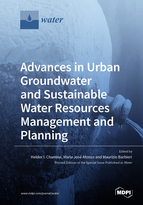Advances in Urban Groundwater and Sustainable Water Resources Management and Planning
A special issue of Water (ISSN 2073-4441). This special issue belongs to the section "Urban Water Management".
Deadline for manuscript submissions: closed (15 December 2021) | Viewed by 33885
Special Issue Editors
Interests: hydrogeological mapping and GIS-based mapping for water resources; hard-rock hydrogeology and water resources; urban groundwater for sustainable water resources management and planning; vulnerability mapping and geohazards; groundwater, geotechnics and rock engineering; hydrogeomechanics and underground environments; history of hydrogeology; military geosciences and groundwater; higher education dissemination and geoprofessional core values
Special Issues, Collections and Topics in MDPI journals
Interests: urban groundwater for sustainable water resources management and planning; urban vulnerability mapping and geohazards; hard-rock hydrogeology and water resources; hydrogeochemistry in both natural and anthropogenic environments; rock–water interactions; hydromineral resources and geothermics; hydrogeotechnics and water well; applied geology and geotechnics
Special Issues, Collections and Topics in MDPI journals
Interests: geochemistry; hydrogeochemistry; groundwater; geochemistry of sustainable processes; geochemical assessment of environmental quality; isotopic geochemistry; groundwater pollution; groundwater remediation; water quality; water safety; sustainable development; environmental geochemistry; climate change; earthquakes; drinking water
Special Issues, Collections and Topics in MDPI journals
Special Issue Information
Dear Colleagues,
In nature, urban groundwater drives many processes, including climatic, geological, geomorphic, geochemical, ecotoxicological, and hydraulic, sustaining several ecological purposes and services. Urban development has a profound impact on hydrological systems. Additional issues in water resource sustainability and hydrological cycle comprehension are added by urbanization. The anatomy of the urban underground is constituted by an intricate network of pipes, conduits, channels, galleries, storm sewers, and other structures that alter the hydraulic conductivity of the geomaterials. In addition, the release of compounds from urban infrastructure alters the chemistry of the surrounding environment and affects water quality. Urban streams (some of them also channeled and shallow buried) receive dissolved and particulate chemical loadings from runoff, sewer connections, direct discharge from other waterways, and interactions with groundwater. Urban runoff chemistry tends to be dominated by material associated with or accumulated on impervious surfaces, such as heavy metals and deicing salt from roadways. Sewage treatment plants are typically designed to remove some, but not all human-produced compounds and suspended material from water. Consequently, these urban buried features act as favorable pathways for the fluid flow of urban-sourced contaminants into the groundwater resources. In addition, ground surface is generally covered and perceived as virtually impervious (e.g., buildings, asphalt, concrete, brick). Nowadays, environmental pressures affect urban groundwater systems, which are faced with increasing urban pressure, overexploitation, contamination/pollution issues, and climate variability.
A paradigm shift based on holistic management is required to design sustainable water systems. Consequently, an urban water framework must be based not only on sustainable technical–scientific studies but also on socioeconomic, cultural, heritage, and ethical challenges.
This Special Issue emphasizes on the presentation and discussion of key studies, model-urban and peri-urban areas, new methods, original papers, and review articles that describe the current state of the art on the challenges and emerging fields related to the mapping, characterization, assessment, mitigation, and protection of sustainable groundwater systems, water–ground interactions, and water resources in urban areas.
Potential topics in urban areas include but are not limited to the following: hydrogeological mapping, hydrogeochemistry, isotope hydrology, hydraulics, water resources, groundwater engineering, and modeling. Other emerging fields in urban studies are most welcome, such as: urban GIS mapping, geovisualisation, and UAV techniques; urban hydrogeomorphology and planning; rural hydrogeology and small-scale water resources management; hydrotoponymy, historical cities, and cultural heritage; smart cities and groundwater; cities, water security and services; and groundwater ethics and urban areas management.
Prof. Helder I. Chaminé
Prof. Maria José Afonso
Prof. Maurizio Barbieri
Guest Editors
Manuscript Submission Information
Manuscripts should be submitted online at www.mdpi.com by registering and logging in to this website. Once you are registered, click here to go to the submission form. Manuscripts can be submitted until the deadline. All submissions that pass pre-check are peer-reviewed. Accepted papers will be published continuously in the journal (as soon as accepted) and will be listed together on the special issue website. Research articles, review articles as well as short communications are invited. For planned papers, a title and short abstract (about 100 words) can be sent to the Editorial Office for announcement on this website.
Submitted manuscripts should not have been published previously, nor be under consideration for publication elsewhere (except conference proceedings papers). All manuscripts are thoroughly refereed through a single-blind peer-review process. A guide for authors and other relevant information for submission of manuscripts is available on the Instructions for Authors page. Water is an international peer-reviewed open access semimonthly journal published by MDPI.
Please visit the Instructions for Authors page before submitting a manuscript. The Article Processing Charge (APC) for publication in this open access journal is 2600 CHF (Swiss Francs). Submitted papers should be well formatted and use good English. Authors may use MDPI's English editing service prior to publication or during author revisions.
Keywords
- Urban hydrological cycle
- Groundwater GIS mapping for urban areas
- Urban hydrogeochemistry and isotopic hydrology
- Urban hydraulics and hydrodynamics
- Urban groundwater recharge
- Urban groundwater, planning, and engineering
- Urban conceptual models and numerical modeling
- Integrated water resources management for urban areas
- Geochemical change
- Ecotoxicology, geomicrobiology, and hydrobiology studies in urban environments
- Environmental risk assessment for urban areas
- Urban groundwater and geohazards
- Uncertainty, variability, and climate change impacts in urban groundwater systems
- Ethics, environment, society, and groundwater for urban areas








